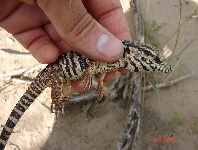|
Red Tegu (Salvator rufescens)
Classification: Introduced Species. It has been introduced to Florida in the United States, although habitat suitability modelling suggests that this arid-adapted species is less well-suited to the environment in Florida than other invasive tegus, and the species is not known to have become established.
Description: As hatchlings, most red tegus display little, if any, red coloration. They are typically brownish-green with black strips across their width and several broken white stripes down their length. They develop red coloration as they mature; males are usually brighter than females. Adult females can reach just under 3 feet in length. Males are significantly larger, reaching up to 4.5 feet and developing large jowls.
Habitat: In the wild, red tegus are diurnal and terrestrial. Living in a temperate climate in Argentina, they brumate in the winter, burying themselves and remaining largely dormant during the coldest periods, in some areas for up to seven months. They also burrow as a matter of habit at other times of year. In the ecotone between the arid Chaco and the Espinal of central Argentina they are known to naturally hybridise with the Argentine black and white tegu (Salvator merianae) with a stable hybrid zone.
Range: This species occurs in western and central Argentina, southeastern Bolivia and northwestern Paraguay
Found in these States:
FL
Diet: The red tegu is a very opportunistic feeder. Wild specimens will eat a variety of plant and animal matter: fruits, vegetables, insects, rodents, birds, and fish. Red tegus raised in captivity will often be more picky eaters, especially as juveniles, and may prefer a diet of mostly meat. Being omnivores, red tegus will eat a diverse range of foods, with a focus on animal protein, including small to medium rodents, birds, many insects, and any dead animal they can scavenge.
Reproduction: Before going for hibernation, red tegu lizards engage in mating, after which the females start laying eggs. Two weeks after they wake up from hibernation, the process of mating begins again, and this process continues. The mother red tegu lays between 12 and 30 leathery eggs in its nest. They have also been observed hiding their eggs inside termite mounds. This helps the eggs remain in optimal temperature and get enough humidity for development. The eggs will hatch after 45 to 60 days, while the baby red tegus remain under the care of the mother until they are matured enough to forage for themselves.
Status: Listed as Least Concern on the basis that this species is very widespread, exhibits a high reproductive rate which has historically rendered it resistant to harvesting pressure, and although deforestation within its range is widespread it can apparently persist within largely degraded areas so long as some suitable vegetation remains. Nevertheless the true population status of this lizard is unclear, and conversion of forest into monocultures within which this species will not persist is widespread and increasing within its range (although not at a rate likely to approach 30% over three generations in this disturbance-tolerant species). Although this species is not thought to be at serious risk of extinction, it may be of conservation concern and further research, including systematic monitoring of subpopulations, is strongly recommended.
»» Kingdom: Animalia - Animals
»» Phylum: Chordata - Chordates
»» Subphylum: Vertebrata - Vertebrates
»» Class: Reptilia - Reptiles
»» Order: Squamata - Lizards
»» Family: Teiidae - Whiptails & Racerunner Lizards
»» Genus: Salvator
»» Species: Salvator rufescens - Red Tegu
»» Subspecies: None
This article uses material from the Wikipedia article "Red Tegu", which is released under the Creative Commons Attribution-Share-Alike License 3.0. Content may have been omitted from the original, but no content has been changed or extended.
|
|







